Infiltration Temperature Effect on Tungsten Copper Electrode Properties IV
- Details
- Category: Tungsten Information
- Published on Monday, 30 November 2015 17:21
In addition, before reaching optimum infiltration temperature, tungsten particles are distributed more evenly, but copper infiltration is not very uniform, after which the temperature rises, copper dissolution, infiltration sufficient. And the infiltration temperature is too high, tungsten particles connections increased risk, the smaller the tungsten particles grew up together, the copper phase distribution network has been hampered, leading to uneven distribution organization.
Overall, the properties of tungsten copper electrode react sensitively to infiltration temperature, which affected by wetting angle, surface tension, viscosity, capillary force, particle rearrangement, solid phase sintering, liquid phase sintering, particle distribution, coupling rate and so on. Therefore, infiltration temperature plays an important role in tungsten copper electrode properties.
More information about infiltration temperature effect on tungsten copper electrode properties, click here:
http://news.chinatungsten.com/en/tungsten-information/80856-ti-10414
http://news.chinatungsten.com/en/tungsten-information/80857-ti-10415
http://news.chinatungsten.com/en/tungsten-information/80908-ti-10421
| Tungsten Copper Supplier: Chinatungsten Online tungsten-copper.com | Tel.: 86 592 5129696; Fax: 86 592 5129797;Email:sales@chinatungsten.com |
| Tungsten News & Prices, 3G Version: http://3g.chinatungsten.com | Molybdenum News & Molybdenum Price: http://news.molybdenum.com.cn |
Infiltration Temperature Effect on Tungsten Copper Electrode Properties III
- Details
- Category: Tungsten Information
- Published on Monday, 30 November 2015 17:08
However, with the increasing infiltration temperature, tungsten skeleton sinter in solid phase, which blocks up the rearrangement of particle during the infiltration of copper liquid. The increasing close pores decrease the density of tungsten copper electrode. When the temperature exceeds the limit, tungsten particles will have sintering aggregation. Meanwhile, in the process of infiltration, the surface tension of liquid copper was plummeting copper liquid by capillary force is reduced, resulting in copper liquid overflow.
The hardness of tungsten copper W-25Cu at different infiltration temperature:

The graph shows that the hardness trend is similar to the density trend of tungsten copper W-25Cu, which increases with the increasing temperature at the beginning, and decreases when the temperature exceeds the limit. Due to the hardness of tungsten-copper alloy essentially depends on the density of tungsten copper alloy, for tungsten copper infiltration, before reaching the best temperature, the density of tungsten copper electrode will increase.
| Tungsten Copper Supplier: Chinatungsten Online tungsten-copper.com | Tel.: 86 592 5129696; Fax: 86 592 5129797;Email:sales@chinatungsten.com |
| Tungsten News & Prices, 3G Version: http://3g.chinatungsten.com | Molybdenum News & Molybdenum Price: http://news.molybdenum.com.cn |
Feature of Tungsten Alloy Similar to Anviloy 1150
- Details
- Category: Tungsten Information
- Published on Monday, 30 November 2015 16:18
Tungsten alloy(90%W4%Ni45Mo2%Fe) similat to Anviloy 1150 material is used in electrobrazing applications where head balance is important. The tungsten lloy similar to Anviloy 1150 material also has good anti-sticking qualities and good high temperature abrasion and hardness properties. The oxidation resistance of both material is excellent up to 1100F.
Features:
High temperature resistant capability
Robust external and internal body
Good thermal conductivity
Better surface finish
Corrosion and heat resistance
Ruggedness
Shock resistant capability
Environment friendly
| 高比重合金供应商:中钨在线科技有限公司 | 产品详情: http://www.tungsten-alloy.com |
| 电话:0592-5129696 传真:5129797 | 电子邮件:sales@chinatungsten.com |
| 钨钼文库:http://i.chinatungsten.com | 钨钼图片: http://image.chinatungsten.com |
| 钨新闻3G版:http://3g.chinatungsten.com | 钼业新闻: http://news.molybdenum.com.cn |


Tungsten Alloy Similar to Anviloy 1150
- Details
- Category: Tungsten Information
- Published on Monday, 30 November 2015 16:08
Tungsten heavy alloy similar to the brand name as Anviloy 1150 is a tungsten-based material with adding a few amount of molybdenum, copper, nickel, iron. With low coefficient of thermal expansion, good thermal conductivity and good material properties, tungsten alloy similar to anviloy 1150 can have less thermal fatigue and soldering in the die cast or extrusion.When the mold has to repeatedly withstand the metal melt at a temperature of over 600℃, we will offer tungsten heavy metal alloy similar to Anviloy 1150 or for your choice.
We will supply tungsten alloy similar to Anviloy 1150 mold inserts, sprue bushes, cooling inserts and other individual parts for die casting, aluminum permanent mold, and difficult extrusions.

| 高比重合金供应商:中钨在线科技有限公司 | 产品详情: http://www.tungsten-alloy.com |
| 电话:0592-5129696 传真:5129797 | 电子邮件:sales@chinatungsten.com |
| 钨钼文库:http://i.chinatungsten.com | 钨钼图片: http://image.chinatungsten.com |
| 钨新闻3G版:http://3g.chinatungsten.com | 钼业新闻: http://news.molybdenum.com.cn |


Infiltration Temperature Effect on Tungsten Copper Electrode Properties II
- Details
- Category: Tungsten Information
- Published on Friday, 27 November 2015 16:51
Infiltration temperature controlling is crucial in the process of tungsten copper electrode, its rise and fall has a great effect on comprehensive performance of tungsten copper electrode. There is a graph of the relation of infiltration temperature and wetting angle as follow.
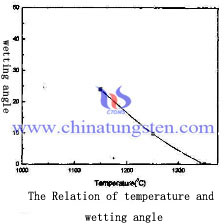
The graph remarkably shows that infiltration temperature plays an important role in diffusion effects. The higher Infiltration temperature, the smaller the infiltrate angle, easily viewed from the figure, the wetting angle decreases with increasing temperature, the surface tension increases with increasing temperature. Theoretically, when the temperature is 1350 ℃, θ = 0°, completely molten copper and tungsten wetting at this time, the infiltration effect is best. And the copper liquid viscosity decreases with increasing temperature, so the temperature can be increased to improve the infiltration of liquid copper flowability, enhanced capillary action, be conducive to infiltration.
More information about infiltration temperature effect on tungsten copper electrode properties, click here:
http://news.chinatungsten.com/en/tungsten-information/80856-ti-10414
| Tungsten Copper Supplier: Chinatungsten Online tungsten-copper.com | Tel.: 86 592 5129696; Fax: 86 592 5129797;Email:sales@chinatungsten.com |
| Tungsten News & Prices, 3G Version: http://3g.chinatungsten.com | Molybdenum News & Molybdenum Price: http://news.molybdenum.com.cn |
Infiltration Temperature Effect on Tungsten Copper Electrode Properties
- Details
- Category: Tungsten Information
- Published on Friday, 27 November 2015 16:47
Infiltration temperature controlling is crucial in the process of tungsten copper electrode, its rise and fall has a great effect on comprehensive performance of tungsten copper electrode. There is a graph of infiltration temperature effect on W-25Cu tungsten copper density as follow.
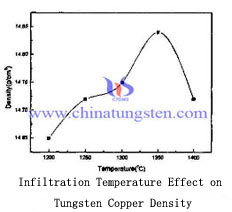
Take W-25Cu tungsten copper electrode as an example, the density of tungsten copper electrode increases with the increasing infiltration temperature in the beginning. When the temperature reaches 1350 ℃, it reaches highest density (14.84g/cm3). However, when the temperature exceeds 1350 ℃, the density tungsten copper electrode decreased. This is because one of the basic conditions necessary for infiltration is infiltration requirements can be well wetted metal matrix material, i.e. 0 ° <θ <90 ° (θ copper and tungsten wetting angle). And smaller θ and the more conducive to infiltration process.
| Tungsten Copper Supplier: Chinatungsten Online tungsten-copper.com | Tel.: 86 592 5129696; Fax: 86 592 5129797;Email:sales@chinatungsten.com |
| Tungsten News & Prices, 3G Version: http://3g.chinatungsten.com | Molybdenum News & Molybdenum Price: http://news.molybdenum.com.cn |
Tungsten Copper Electrode Infiltration Mechanism III
- Details
- Category: Tungsten Information
- Published on Thursday, 26 November 2015 17:08
Infiltration is the most widely used in tungsten copper electrode manufacturing so that the study on mechanism of tungsten copper electrode is also important. However, not any two kinds of metal can be used in infiltration.
There are some essential basics for tungsten copper infiltration:
1. Infiltrated metal (Cu) can wet the skeleton material (W) completely.
2. There is a great difference of melting point between skeleton material (W) and infiltrated metal (Cu) in case of the deformation of parts.
3. The solubility of the skeleton (W) and infiltrated metal (Cu) should be low or immiscible so that the liquid phase will disappear when the compounds or solid solution emerging after the reaction.
4. The amount of infiltrated metal (Cu) should be limited by fill-in the pores, more or less will have negative influence.
More infomation about tungsten copper electrode infiltration mechanism, click here:
http://news.chinatungsten.com/en/tungsten-information/80768-ti-10409
http://news.chinatungsten.com/en/tungsten-information/80801-ti-10412
| Tungsten Copper Supplier: Chinatungsten Online tungsten-copper.com | Tel.: 86 592 5129696; Fax: 86 592 5129797;Email:sales@chinatungsten.com |
| Tungsten News & Prices, 3G Version: http://3g.chinatungsten.com | Molybdenum News & Molybdenum Price: http://news.molybdenum.com.cn |
Tungsten Copper Electrode Infiltration Mechanism II
- Details
- Category: Tungsten Information
- Published on Thursday, 26 November 2015 17:02
Spontaneous infiltration filled the porous tungsten matrix with molten copper solution by means of capillary force rather than the diffusion of atoms. Viewed from the mechanism of capillary, the gravitational potential energy of the capillary liquid should come from inside the liquid molecules into the adhesive layer for the loss of potential energy. Because the potential energy in the adhesion layer should be smaller than in the liquid inside, according to the potential energy minimum principle in stable equilibrium, the molecules inside the liquid have to squeeze into the adhesive layer so that the adhesive layer has a tendency to stretch.
The potential higher copper solution continuously into the inner molecular layer attached to the lower potential, the molecules will keep the potential loss of gravitational potential energy is converted into the molecule, so the liquid rising in the capillary.
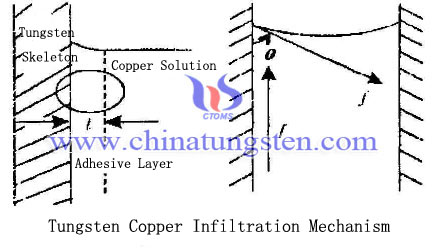
More infomation about tungsten copper electrode infiltration mechanism, click here:
http://news.chinatungsten.com/en/tungsten-information/80768-ti-10409
| Tungsten Copper Supplier: Chinatungsten Online tungsten-copper.com | Tel.: 86 592 5129696; Fax: 86 592 5129797;Email:sales@chinatungsten.com |
| Tungsten News & Prices, 3G Version: http://3g.chinatungsten.com | Molybdenum News & Molybdenum Price: http://news.molybdenum.com.cn |
Ti-W-Si-Al Based Coated Tungsten Carbide End Mills In Cutting Hardened Steel Ⅵ
- Details
- Category: Tungsten Information
- Published on Thursday, 26 November 2015 16:06
In last part we know that tungsten carbide end mills with (Ti,Al)N, (Ti,W)N/(Ti,W,Si)N, and (Ti,W)N/(Ti,W,Si,Al)N coating films will be tested to know the tool wear, because the exact features of new titanium/tungsten/silicon/aluminum-based coating films are still unknown for cutting hardened steel. Here in this part we explain the experimental procedures.
2. Experimental Procedures
The work material used was hardened steel (AISI D2,60HRC). The chemical composition of the hardened steel is shown in Table 1. The tool material of the substrate was cemented carbide, and three types of PVD-coated cemented carbide were used as shown in Table 2. Namely, the coating films used were (Ti,W)N/(Ti,W,Si)N and (Ti,W)N/(Ti,W,Si,Al)N coating film. (Ti,W,Si,Al)N is a new type of coating film. (Ti,W)N/(Ti,W,Si)N and (Ti,W)N/(Ti,W,Si,Al)N comprise a multilayer coating system.
The inner layer of the (Ti,W)N/(Ti,W,Si)N and (Ti,W)N/(Ti,W,Si,Al)N coating system is (Ti,W)N coating film, and the outer layer is (Ti,W,Si)N and (Ti,W,Si,Al)N coating films, respectively. Furthermore, commercial (Ti,Al)N-based coating film was also used as the (Ti,Al)N.
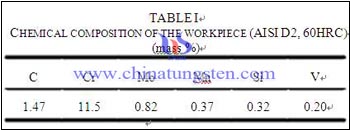
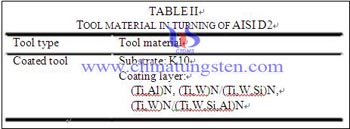
(To be continued. This article is divided into several parts. Here is part 6. For part 5 please refer to http://news.chinatungsten.com/en/tungsten-information/80796-ti-10487)
| Tungsten Carbide Supplier: Chinatungsten Online tungsten-carbide.com.cn | Tel.: 86 592 5129696; Fax: 86 592 5129797;Email:sales@chinatungsten.com |
| Tungsten News&Tungsten Prices, 3G Version: http://3g.chinatungsten.com | Molybdenum News & Molybdenum Price: http://news.molybdenum.com.cn |
Ti-W-Si-Al Based Coated Tungsten Carbide End Mills In Cutting Hardened Steel Ⅴ
- Details
- Category: Tungsten Information
- Published on Thursday, 26 November 2015 16:06
In last part we know that tungsten carbide tools with (Ti,W,Si)N coating film are better in wear resistance, hardness and critical scratch load, and so is maybe more effective material for cutting hardened steel. Here in this part we explain why we choose (Ti,Al)N, (Ti,W)N/(Ti,W,Si)N, and (Ti,W)N/(Ti,W,Si,Al)N coating films as the testing materials.
Furthermore, new titanium/tungsten/silicon/aluminum-based coating films, namely (Ti,W,Si,Al)N, (Ti,W,Si,Al)C, and (Ti,W,Si,Al)(C,N) coating film, have been developed. However, it is not clear whether these coating films are effective tool materials for milling hardened steel.
In this study, hardened steel was milled with three physical vapor deposition (PVD)-coated cemented tungsten carbide end mills in order to clarify effective tool materials for cutting hardened steel at high cutting speeds. The coating films used were (Ti,Al)N, (Ti,W)N/(Ti,W,Si)N, and (Ti,W)N/(Ti,W,Si,Al)N coating film. The tool wear was experimentally investigated.
(To be continued. This article is divided into several parts. Here is part 5. For part 4 please refer to http://news.chinatungsten.com/en/tungsten-information/80792-ti-10486; for part 6, please refer to http://news.chinatungsten.com/en/tungsten-information/80797-ti-10488)
| Tungsten Carbide Supplier: Chinatungsten Online tungsten-carbide.com.cn | Tel.: 86 592 5129696; Fax: 86 592 5129797;Email:sales@chinatungsten.com |
| Tungsten News&Tungsten Prices, 3G Version: http://3g.chinatungsten.com | Molybdenum News & Molybdenum Price: http://news.molybdenum.com.cn |



 sales@chinatungsten.com
sales@chinatungsten.com